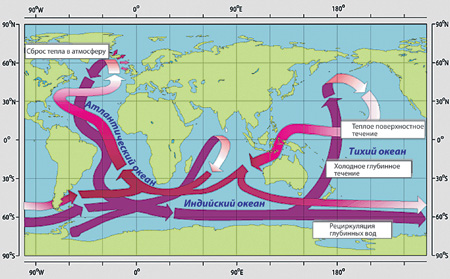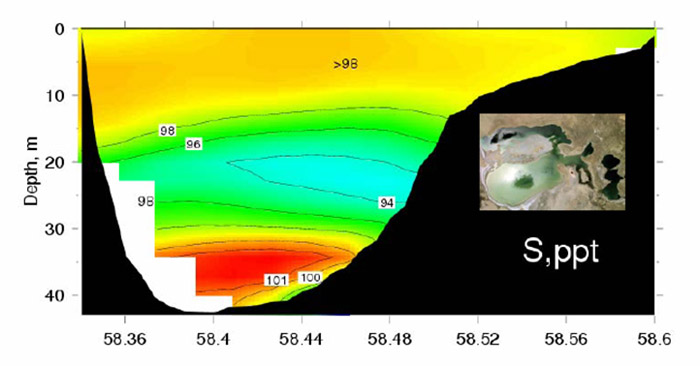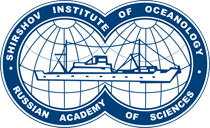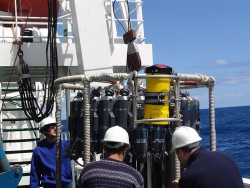OCEAN PHYSICS
Division Head Vyacheslav Kremenetsky
1946 Fundamental role of the spatial non-uniformity of the wind field in the formation of ocean circulation. Theory of the equatorial countercurrent.
1967 Theory of ocean turbulence.
1970 Synoptic eddies. POLYMODE, a large-scale experiment in the Atlantic.
1995-2016 instrumental observations of hydrological features of the North Atlantic along the 60oN.
2002-2016 Regular expeditions to the South Atlantic and performing transoceanic hydrophysical sections.
2015 Deep convection is found in the subpolar Atlantic and record lowering of surface water to depths > 1.5 km.
Children categories
Sea-Air Interaction and Climate Laboratory (SAIL)
Head: Associated member of RAS, Prof. Sergey Gulev
Department of large-scale processes and climate
Website of the laboratory: sail.ocean.ru

The main directions of study:
Ocean-atmosphere interaction at various time-scales.
Ocean general circulation modeling.
Cyclone activity in the mid-latitudes.
European continental climate changes and tropical latitudes changes of the Indian and Pacific Oceans.
Parameterization of short wave radiation at sea surface.
Development of the global and regional climatologies of ocean waves characteristics.
Planetary wave impacts on stratospheric dynamics.
Laboratory of Large-Scale Variability of Hydrophysical Fields
Head: Prof. Vladimir Byshev
Department of large-scale processes and climate

The main directions of study:
Anomalies in intrasecular oscillations of climatic characteristics of the ocean and atmosphere in their interplay.
Numerical modeling of thermodynamic parameters of the upper active layer of the ocean.
Laboratory modeling of coherent dynamic structures.
Diagnosis of the largescale hydrophysical ocean system.
Geophysical Fluid Dynamics Laboratory
Head: Prof. Gregory Reznik
Department of large-scale processes and climate

The main directions of study:
Ocean waves, eddies and large-scale currents responsible for climate and weather formation on the Earth.
Western boundary currents dynamics (the Gulf Stream, Kuroshio, etc.).
Various types of wave motions in the ocean and the atmosphere.
Synoptic eddies and Rossby waves determining the ocean and the atmosphere dynamics; a number of the results have also been applied to plasma physics and astrophysics.
Non-Linear Wave Processes Laboratory
Head: Prof. Sergey Badulin
Department of large-scale processes and climate

The main directions of study:
Physics of non-linear evolution of ocean wave fields (surface, internal, capillary) and their mathematical description.
Theories of surface waves dynamics for remote sensing of sea surface.
Principles of formation and decay of inner thermocline eddies and their interactions with the bottom topography.
Group of Climate Variability Model for Oceans and Seas
Head Associated member of RAS, Prof. Rashit Ibraev
Department of large-scale processes and climate

The main directions of study:
Physics of the ocean, large and mesoscale hydrodynamics of the sea.
Mathematical modeling of the dynamics of the World Ocean and inland seas.
Climatic variability.
Synoptic variability.
The Caspian Sea, the Black Sea, the World Ocean.
Laboratory of Land-Ocean Interactions and the Anthropogenic Impact
Head: Associated member of RAS, Prof. Peter Zavialov
Department of Coastal and Mesoscale Oceanology
Website of the laboratory: land.ocean.ru

The main directions of study:
Impacts of continental discharges on the marine systems.
Anthropogenic impacts on the ocean and inland water bodies.
Remote sensing of the ocean.
Climate variability at different scales.
Marine Turbulence Laboratory
Head: Prof. Viktor Zhurbas
Department of Coastal and Mesoscale Oceanology

The main directions of study:
Ocean microstructure: turbulence, double diffusion, differential mixing.
Modeling of mesoscale processes in the ocean in the framework of eddy-resolving models.
Intrusive stratification of ocean fronts: modeling, analysis of empirical data.
Simulation of deep-sea oil spills.
Lateral mixing in the ocean according to drifters.
Ocean Optics Laboratory
Head: Dmitry Glukhovets
Department of Coastal and Mesoscale Oceanology

The main directions of study:
Seawater optical characteristics.
Light fields in the ocean from natural and artificial sources.
Development and use of optical and radiophysical methods (contact and remote, including satellite). for the study and monitoring of seas and oceans.
Group of Radiophysics of the Ocean:
Investigations of the fields of the reflected and intrinsic radio emission of the ocean in their interrelation with hydrophysical, acoustic and optical fields and phenomena.
Atlas of Bio-optical Characteristics of the Russian Seas According to Satellite Ocean Color Scanners: optics.ocean.ru
Laboratory of Noises and Sound Fluctuations in the Ocean
Head: Prof. Alexander Vedenev
Department of Coastal and Mesoscale Oceanology

The main directions of study:
Investigation of physical processes in the ocean by remote acoustic methods.
Acoustic tomography using pseudo noise signals.
Development of technical means for research and monitoring of underwater noise in real time.
Numerical modeling of safety zones in the acoustical impact of anthropogenic noise in marine mammals.
Passive acoustic monitoring of industrial noise for detection and identification of marine mammals by their acoustic signals.
Experimental Ocean Physics Laboratory
Head: Prof. Andrey Zatsepin
Department of Ocean Dynamics

The main directions of study:
Mesoscale hydrophysical processes in the World Ocean and in the Russian seas.
Water exchange between the shelf zone and the open sea – field and lab experiments.
Satellite monitoring of the Russian seas and selected areas of the World ocean.
Development of new oceanological instruments and their introduction into the practice of marine research.
Sea Currents Laboratory
Head: Prof. Vladimir Zhmur
Department of Ocean Dynamics

The main directions of study:
Southern Ocean, its currents, fronts, water masses, ice, thermal interaction with the atmosphere.
Physicochemical properties of water masses of the Pacific sector of the Southern Ocean and the boundaries between water masses.
Intermediate layer of Antarctic water in the Pacific, Indian and Atlantic oceans.
Interannual and seasonal variability in the distribution of icebergs in all sectors of Antarctica and its relationship with El Ni?o.
Laboratory of Hydrological Processes
Head: Prof. Evgeniy Morozov
Department of Ocean Dynamics

The main directions of study:
Topographic forcing of circulation and internal waves.
Currents in the abyssal channels of the Atlantic (Vema channel; Romanche, Chain, Vema, etc. fracture zones).м Internal tides.
Inertial oscillations. Ocean currents.
Polar oceanography group:
Large-scale and mesoscale processes in the Arctic Ocean.
North Atlantic water masses, their formation, climatic variations and thermohaline circulation.
Laboratory of Marine Meteorology
 Head: Natalya Tilinina
Head: Natalya Tilinina
Department of large-scale processes and climate
The main directions of study:
Study of mesoscale and synoptic processes in the near-surface layers of the atmosphere and ocean.
Monitoring wind waves in the open ocean.
Development of the created SeaVision system, which allows to obtain operational information about the state of the surface of the World Ocean.




